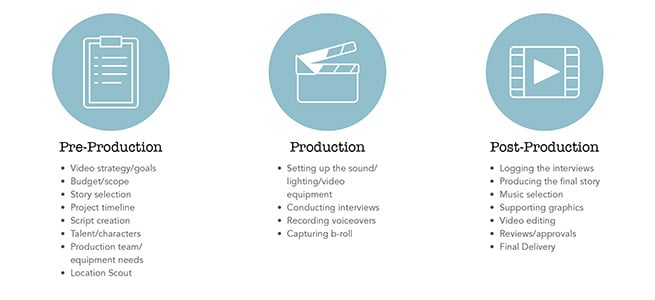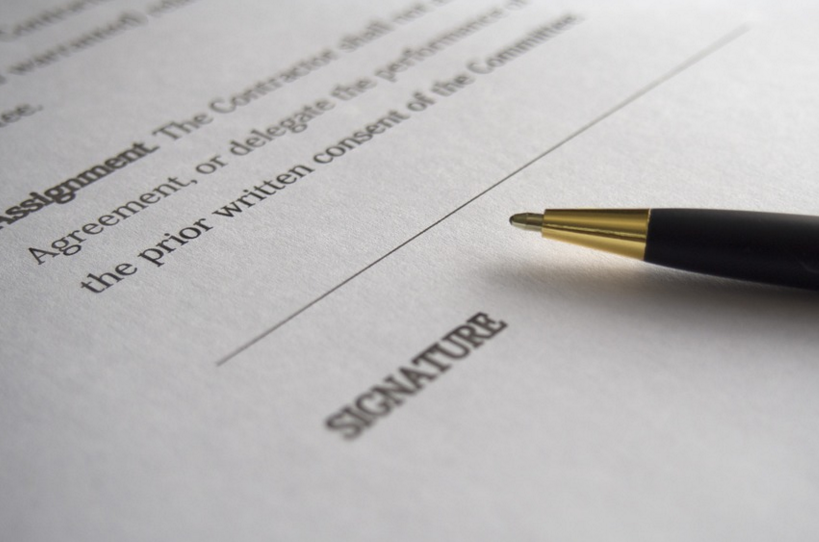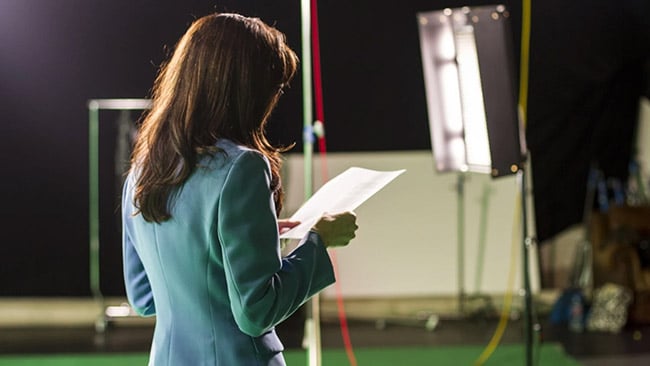Checklist: Determine the Scope of Work for a Video Production Project
Editor's Note: This blog was originally published in 2015 and was updated in March 2023.
5 min read
 Ed Heil
:
May 2, 2022 9:47:00 AM
Ed Heil
:
May 2, 2022 9:47:00 AM

Recording videos today is easier than ever thanks to the high-quality video cameras built into most cell phones, accessibility of excellent microphones that hook right into those phones, and simple to use lighting you can buy online and have delivered right to your door. But producing a great video still takes forethought, planning, and an understanding of the video production process from concept to completion.
 Video Production Process: The Building Blocks
Video Production Process: The Building BlocksWhile the video production process will vary based on the style, content, timeline, effort, and budget, there are some basic building blocks that are constant among successful video producers.

The first step in the process of creating a video is all about preparation and setting the groundwork. During this phase, it's essential to do the planning, research, problem-solving, and organization necessary to set your video project up to be successful.
The pre-production phase includes:
In order to identify all of these elements, a series of meetings may be needed. Again, this process will vary based on the team and the scope of your project, but here are some basics to help you get started.
Fact Finding: Bring your company stakeholders and video production team together to discuss the purpose, strategy, and goals for your video and how it will be used after it is finalized. If you are planning to work with an external video production company, this is the part of the process where you'll want to communicate things like branding, target audience, and the tone and feel for the piece.
Pre-Production Meeting: This meeting is typically held between your video producer and the primary point person for the project. Make sure to set the timeline, identify the characters, and finalize any location details. This meeting can be done over the phone or in person.
Site Visit (Optional): Depending on the complexity of the shoot, it can be helpful to do a site visit to your location, especially if neither the producer or videographer has seen it.
Shoot Preparation: Prior to showing up on-site for your video shoot, your video producer should ensure that scripts have been reviewed and approved, interview questions discussed, characters are vetted, schedule is finalized and locations are confirmed. All these details will help ensure that the production phase goes smoothly.
The meetings are over, the preparation is complete. Now, it's time to have some fun! The production phase is where you capture all the interviews and footage for your video. This is the part where the story begins to come to life.
The production phase is where all the raw materials for your video will be captured. If you have specific visions, ideas, or visuals that you want to be included in the final product, be sure that you have clearly communicated that with your producer before the end of the production phase.
The production phase includes:
Especially if you are using an external video team, we recommend the primary point person is on location to act as the conduit between the video producer and your brand.
After the production phase is finished, the producer and editor go to work. During the post-production phase, your video production team will begin the process to organize, plan, and edit the actual video.
Your producer will carefully review all the footage and transcribe all of the interviews conducted. Then, they will assemble the story and the video editor does their magic to bring all the pieces together.
The production phase includes:
Your video production team will handle all the nuts and bolts of making your project come to life. So, just sit tight and wait for the magic to happen. This process takes some time and creativity, so don't expect that it will happen overnight.
Every production company will have different timelines for the post-production phase, but you can plan for it to take approximately 6-8 weeks unless you've discussed another plan with your company.
Note: if you are looking for a project with a shorter turnaround time, be sure to mention that to your video team. Many companies have the ability to work within your timeline if you make that clear from the beginning of the project.
Once your video team has created a draft of the video project, it'll be time for your project point person and key stakeholders to step back into the mix:
Initial approval and revisions: Once the initial version of the video is edited, it's time to review the work. Assuming there are some changes that need to be made, the revision process can begin. If you are working with a video company, there may be a pre-defined number of revisions or hours set aside for revisions.
Final Delivery: Once the video is finalized and approved, it's time to export the video to its final format. If you are planning to use the video on a specific platform (or platforms) be sure to communicate that with your video team. All platforms (YouTube, Facebook, etc) have slightly different specifications for optimal video playback.
Related Blogs: |
Dependability: Whether you're shooting on location, in a studio, at your office, or at a friend's home, there are a lot of moving pieces that have to come together. Does the time and place work for all members of the crew? How about actors or spokespeople? Identifying all of these details is crucial, and it is essential to do it in a logical, systematic fashion.
Predictable Timeline: Video production takes time. For anything more than an iPhone video, you don't just pick up a camera one day and have a video in your hands the next. So, how much planning time do you need before the shoot and how much editing time afterward? It's only guesswork unless you have a real process. An established and tested video process can help you go from an educated guess to an accurate prediction.
Accurate Pricing: Speaking of pricing, most production rates are based on time. The more hours required to plan, shoot, and edit the project, the more it costs. And when you add extra days or crew members, that obviously adds to the total time (and price).
Fewer Revisions: When you nail down your objectives, discuss the details in pre-production, and then execute to match your vision, you shouldn't end up with many revisions at the end of your project. On the other hand, if you go through that whole project without a real process, you may end up with problems that require extra editing and time to resolve.
Different production companies and videographers may have different processes, but the bottom line is that process allows video teams to have a predictable pace, dependable results, ensures quality and accountability.
At StoryTeller, our process was modeled after the television newsroom production process. Take a look at how our process differs slightly from the standard process listed above:
While every production company and video project are different, there are some key elements that will help your video project go as smoothly as possible. Whether you are working with your internal video team or a video production company, make sure that you have an established video production process that helps account for all the different variables of your project.
Editors Note: This blog was originally published in October 2015 and was updated May 2022.

Editor's Note: This blog was originally published in 2015 and was updated in March 2023.

You understand how important video is. People today expect to see videos when they’re deciding whether to work with a company or buy a product. In...

You’ve brainstormed, planned, and found the budget, but are you ready to actually put together that marketing video? If you don’t have a written...